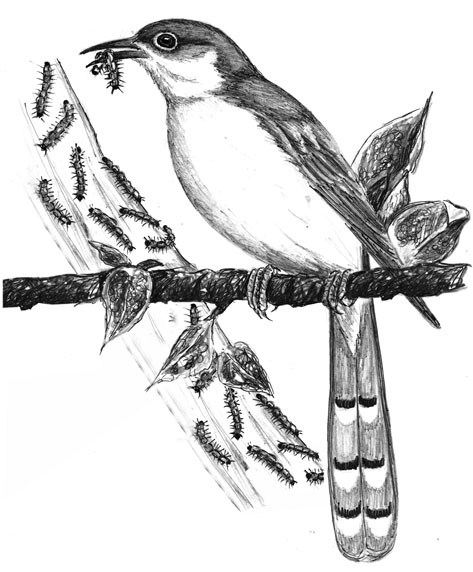
Dear Bird Folks,
Can you hear the bird that is singing in my yard? If so, please tell me what it is. I’ve been hearing it for several days in a row but I can never find it.
– Ann, North Eastham, MA
Author’s note:
This question is based on a phone call I received from Ann, who asked me to identify a singing bird via the telephone, which I did. Unfortunately, I never bothered to ask her if the bird I heard was from a recording that she had made earlier or if she was actually holding her phone out the window so I could hear the bird live. Why do I care? I like having the image of Ann holding her phone out the window while her neighbors wonder what the heck she was up to. Perhaps they thought she was a low-tech spy, eavesdropping on the neighborhood. Or maybe they figured that she was just plain cuckoo, and that is the answer to her question.
It’s a cuckoo, Ann,
The bird you are hearing is a cuckoo, a Yellow-billed Cuckoo to be exact. You are lucky to be hearing one because most Cape Codders never hear these birds, and even fewer ever see them. While cuckoos breed on the Cape every summer, some years are better than others and this year appears to be a good one. Several other customers have also mentioned hearing cuckoos, plus I’ve heard quite a few myself. But hearing cuckoos and seeing cuckoos are two different things. Even though they are noisy birds, they are notoriously hard to spot…as you are finding out. Spotting a cuckoo is like finding a parking space in Provincetown in the summer. Okay, maybe they aren’t that hard to find, but they aren’t easy.
Here in Massachusetts, and in most of the United States, we have two species of cuckoos. There is the Yellow-billed Cuckoo, like the one you are hearing, and the black-billed. With the exception of the bill color, both species are fairly similar in appearance and behavior. Cuckoos, which are about the size of a Blue Jay, are slender gray-brown birds, with lengthy tails and long, down-curving beaks. You might think that a bird this large would be easy to find, especially if it’s singing, but take it from me, it’s not. This spring alone I’ve spent many hours trying to track down singing cuckoos and have only managed a few fleeting glimpses. My latest attempt was in a cemetery near my house. (My neighborhood is nothing but houses on top of houses, so the local cemetery is the only green space I have access to, which isn’t really too bad, especially since the cemetery occupants never bother me.)
On this particular day I was busy watching a bluebird family, when I heard the distinctive “cucucu, cucucu, cucucu” voice of the Black-billed Cuckoo. Typically, these birds sing from deep inside thick vegetation, so I wasn’t holding out much hope of actually seeing one. But as I followed the sound, it led me away from the thickets to the middle of the cemetery. The cuckoo was actually singing in a small tree right next to where I had parked. Sweet! After months of tracking, I was finally going to get a good look at one of these elusive birds. As I approached the tree the bird kept singing and I kept looking. This busy tree was filled with other birds, too. I spotted several chickadees, orioles and titmice, but do you think I could find the much larger, relentlessly singing cuckoo? Nope. I walked around and around the tree and even tried doing my own “cucucu” imitation, hoping the bird would move a little, or at least laugh, but nothing. Finally, the bird got tired of my bad impression and flew off, never to be heard from again. So once more my only view of a cuckoo was a very fleeting glimpse. Curses.
It’s not that cuckoos are particularly shy birds, but living in thick foliage is just their method of operation. Cuckoos are predominantly insect eaters, but unlike other insect eaters that prefer to capture prey on the wing, cuckoos wait for the food to come to them. They spend hours just hiding in the bushes or tree branches until something yummy comes into sight. When prey is spotted the birds hop out, grab the food, eat it and then resume waiting again. And what do they like to eat, you ask? I just told you, “insects.” Weren’t you paying attention? In addition to typical insects, cuckoos also like to eat one creature that nearly all birds avoid and most humans despise. I’m talking about caterpillars, particularly hairy caterpillars. Those nasty gypsy moth and tent caterpillars that eat the trees and freak us out are like Godiva chocolate to cuckoos, only without the exorbitant price tag.
When there’s a caterpillar outbreak, like we are having this year, cuckoos become very active breeders and this may explain why so many people have been hearing them lately. And sometimes, when there is a surplus of food, the female will produce more eggs than she can incubate, so she “shares” them. North American cuckoos have been known to lay extra eggs in the nests of other birds. However, this rare event is likely based on food abundance and is not the norm. Don’t confuse our cuckoos with the parasitic Common Cuckoo of Europe. Our birds have a lot more style than those wacky things in Europe.
Enjoy your calling cuckoo, Ann. Maybe if you look hard enough and get lucky, you might even see one. And if you get real, real lucky, maybe you’ll even find a parking space in Provincetown this summer. Oh, who am I kidding? That will never happen.